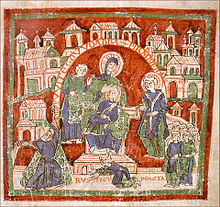Witigowo
Witigowo (* in the 10th century ; † June 16, 997 in Reichenau ) was abbot of the Reichenau monastery from 985 to 996 .
Live and act

Before Witigowo in August 985 by Otto III. was appointed abbot, he was a monk in Reichenau monastery.
The work of Witigowo was described in 995 on the occasion of the ten-year abbot anniversary by the Reichenau monk Purchard in a biography, the Carmen de gestis Witigowonis abbatis , commonly known as Gesta Witigowonis . According to the Purchards report, the main focus of Witigowo's Abbatiat was a wide range of construction activities on the Reichenau. In many parts of the biography is a list of his services to the decoration of the Reichenau churches and the veneration of saints.
In 996 Witigowo resigned from his office. The exact circumstances that forced him to abdicate are unknown and can only be guessed at. Apparently he had numerous opponents within his convent who, due to his enthusiasm for building, the immense construction costs associated with it and his frequent absence in the service of Otto III. criticized.
Construction activity
Witigowo not only redesigned the Reichenau Minster by extending and raising the nave and erecting a new altar to worship St. Mark , but also built numerous chapels and churches in the vicinity of the minster. As early as 985, at his instigation, a church was built in honor of St. Januarius , in 986 a chapel in honor of the founder of the monastery, Pirmin, and in 992 a church consecrated to St. Bartholomew as well as a Erasmus and Heraclius chapel .
Furthermore, in 995 he had a palace for Emperor Otto III in the immediate vicinity of the monastery church . erect. Whether Otto III. ever stayed there is not known. The Palatinate building served the Reichenau abbots as a residence and quarters for kings, emperors and other high-ranking guests until the 13th century.
Witigowo was considered a friend of the arts and had the monastery rooms decorated with numerous paintings. In addition, the Reichenau painting school experienced its artistic peak during his tenure. It is very likely that the wall paintings in the Georgskirche in Oberzell were also made on his behalf.
Ties to kingship and papacy
Abbot Witigowo also had a significant influence on Otto III's policy. His close, trusting relationship with the ruler is evident not only in the fact that he had a palace built in his honor on the monastery island, but also through two trips to Rome that he undertook in the king's entourage. In April 990, the king confirmed the privileges already granted to Reichenau Monastery, in particular immunity , freedom from customs duties , certain tithe rights and the right to vote for abbots.
In 996 Witigowo attended Otto's coronation as emperor in Rome and also used his stay in Rome to intensify the ties between his monastery and the papacy. Already in 990 Pope John XV. the Reichenau abbot confirmed the privileges of his monastery and gave him a valuable relic , a crystal bottle with the blood of Christ .
literature
- Walter Berschin , Johannes Staub (ed.): The deeds of the abbot Witigowo von der Reichenau (985-997). A contemporary biography by Purchart von der Reichenau . Thorbecke, Sigmaringen 1992, ISBN 3-7995-4165-9 .
- Konrad Beyerle : From the foundation to the end of the baronial monastery (724-1427) . In: Konrad Beyerle (ed.): The culture of the Reichenau Abbey. Commemorative pamphlet for the twelve hundredth anniversary of the founding year of the island monastery 724–1924 . 1st subband. Verlag der Münchner Drucke, Munich 1925, p. 112.
- Immo Eberl : Witigowo. In: Historical Lexicon of Switzerland .
Individual evidence
- ^ Regest of Otto III. , in: Regesta Imperii Online (accessed March 23, 2014)
- ↑ a b Thomas Zotz : Between King and Duke. On the situation of Reichenau Abbey in Ottonian Swabia . In: Uwe Ludwig (Ed.): Nomen et Fraternitas. Festschrift for Dieter Geuenich on the occasion of his 65th birthday (R eallexikon der Germanischen Altertumskunde, supplementary volumes; vol. 62), de Gruyter, Berlin 2008, ISBN 978-3-11-020238-0 , pp. 721-740, here p. 731.
- ↑ Helmut Maurer : Legal claim and spiritual dignity of the Reichenau Abbey under Emperor Otto III . In: Helmut Maurer (Ed.): The Reichenau Abbey. New contributions to the history and culture of the island monastery ( Bodensee library ; vol. 20). Thorbecke, Sigmaringen 1974, ISBN 3-7995-6709-7 , pp. 255–275, here p. 259.
- ↑ Thomas Kreutzer: Faded gloss. Nobility and reform in the Reichenau Abbey in the late Middle Ages ( publications by the Commission for Historical Regional Studies in Baden-Württemberg ; Series B; 168). Kohlhammer Verlag, Stuttgart 2008, ISBN 978-3-17-019760-2 , p. 74.
- ^ Konrad Beyerle: From the foundation to the end of the baronial monastery (724-1427) . In: Konrad Beyerle (ed.): The culture of the Reichenau Abbey. Commemorative pamphlet for the twelve hundredth anniversary of the founding year of the island monastery 724–1924 . 1st subband. Verlag der Münchner Drucke, Munich 1925, p. 112.
| predecessor | Office | successor |
|---|---|---|
| Ruodmann |
Abbot of Reichenau 985-997 |
Alawich II. |
| personal data | |
|---|---|
| SURNAME | Witigowo |
| BRIEF DESCRIPTION | Abbot of Reichenau Monastery (985–996) |
| DATE OF BIRTH | 10th century |
| DATE OF DEATH | June 16, 997 |
| Place of death | Reichenau |